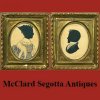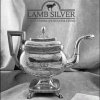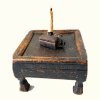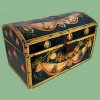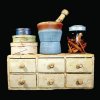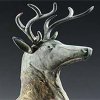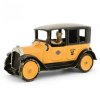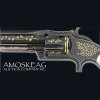Doyle, New York City
Photos courtesy Doyle
Only at Doyle on Manhattan’s Upper East Side can you buy a sterling silver child’s highchair tray, a silver dog bowl, and a silver terrapin tureen and soup bowls in an Americana sale. The April 10 sale featured paintings, prints, furniture, silver, and decorative art. Results for paintings and prints are covered separately; see page 84.

Gorham sterling silver child’s highchair tray, first quarter of the 20th century, demilune form, each panel with a different acid-etched bird, and the corners with foliate scrolls, 15" long x 9½" deep, approximately 24 ounces, sold for $1792 (est. $1000/2000). It was made for a child named Robert, whose name is engraved in a frame between “Bob White” and “Blue Heron.”

Gorham sterling silver dog bowl, 1913, from a New York estate, the circular bowl with sides that slope to a square base with cut corners, engraved with ribbon-tied floral swags, the base 8½" square, approximately 13 ounces, sold for $1664 (est. $500/700).
The Gorham sterling silver child’s highchair tray from the first quarter of the 20th century, with a variety of acid-etched birds and with the name “Robert” engraved front and center, was estimated at $1000/2000 and sold for $1792 (includes buyer’s premium). The Gorham silver dog bowl made in 1912 sold for $1664 (est. $500/700). The Gorham Martelé terrapin soup tureen with a turtle finial and 12 soup bowls, 1912, offered in two lots, sold to the same buyer for a total of $30,720 and will stay together. The tureen sold for $16,640 (est. $10,000/20,000), and the soup bowls for $14,080 (est. $7000/10,000).

Soup tureen on stand, 1912, the bombé-form body and domed cover chased with scrolling seaweed and engraved horizontal bands to replicate water, the finial with a turtle, all raised on a stand with stylized shell-and-seaweed feet, 14" high overall, length over the handles 13", and approximately 124 ounces total, it sold for $16,640 (est. $10,000/20,000). Gorham’s archives list four “terrapin sets” in its inventories. Another terrapin tureen, of a differing model and earlier date (1905), and 12 bowls sold at Sotheby’s New York, April 19, 2023, at the Wolf family’s “The Spirit of America” sale for $38,100 (est. $20,000/30,000).

Set of 12 Gorham Martelé sterling silver terrapin soup plates, 1912, with scalloped borders with wide cavetto chased and engraved with turtles, shells, and seaweed, 8½" diameter, approximately 147 ounces total, sold for $14,080 (est. $7000/10,000).
Another Gorham terrapin tureen and 12 soup bowls of a slightly different model, also with a turtle finial and with turtles around the rims of the bowls, made in 1905, sold at Sotheby’s New York at the Wolf family’s “The Spirit of America” sale April 19, 2023, for $38,100 (est. $20,000/30,000). Terrapin soup, made with the sweet white meat of diamondback turtles with cream, butter, and a healthy dose of sherry or Madeira wine, was served in Andrew Jackson’s White House and later in the 19th century at Delmonico’s restaurant in New York City until sherry and Madeira could not be bought legally during Prohibition and turtles became an endangered species.

Carved and painted wood Ringling Brothers and Barnum & Bailey toy circus, 1970s, from an Upper East Side Manhattan estate, including a cage wagon with lions, a bandwagon with approximately 21 musicians, a team of approximately 48 horses, 9 horses and riders, an Uncle Sam figure, a “Police Patrol” wagon, magician figures, circus barrels, a swan-form wagon, camels, elephants, dogs, horses, acrobats, 5 zebras, a gold-painted elephant with an acrobat, and a felt pennant, approximately 100 pieces, sold for $15,360 (est. $3000/5000).
Two determined bidders competed for a Ringling Brothers and Barnum & Bailey toy circus with about 100 pieces, probably made in the 1970s, that sold for $15,360. The bandwagon had more than 21 musicians, and the set had lots of horses along with camels, elephants, dogs, acrobats, five zebras, and a gold-painted elephant.

Federal inlaid mahogany shelf clock by Aaron Willard, Boston, early 19th century, the white-painted kidney-form iron dial lettered “Aaron Willard / Boston,” the hood with conforming shaped glass and mid-molding above a bird’s-eye maple cross-banded base, all raised on flaring feet, 36¾" high, sold for $19,200 (est. $2000/3000).

Queen Anne walnut and maple tray-top tea table by David Sherrill, East Hampton, New York, mid-18th century. The overhanging top above a shaped apron with drop pendants joins four spurred cabriole legs ending in pad feet. One of the feet has been replaced. The table was probably made for the cabinetmaker’s father, Recompence Sherrill, whose initials are incised on the underside. The 27¼" high x 31" wide x 26¾" deep table sold for $7040 (est. $4000/6000). This table is illustrated and discussed in Long Island Is My Nation by Dean F. Failey (1976).
Furniture was not ignored and provoked some good competition. “It was gratifying to sell to people in the salesroom competing with a good number of buyers online from all corners of the country, the majority on Doyle Live and some on LiveAuctioneers and Invaluable,” said Chris Barber, Doyle’s director of American furniture and decorative arts. About 15 bidders competed live in person.
A Federal inlaid mahogany shelf clock with a kidney-shaped dial made by Aaron Willard, Boston, in the early 19th century sold for $19,200 (est. $2000/3000). A walnut and maple tray-top tea table made in the mid-18th century by David Sherrill in East Hampton, New York, sold for $7040 (est. $4000/6000). It is discussed by Dean F. Failey in his 1976 book Long Island Is My Nation.

Aesthetic Movement rosewood and mixed-metal table inlaid with a mother-of-pearl spider web and other insects, attributed to A. and H. Lejambre, circa 1880, with turned supports joined by shelves and turned diagonal stretchers, on flared brass legs ending in ball feet, 28" high x 36" wide x 20" deep, sold for $10,240 (est. $600/900).
An Aesthetic Movement rosewood table inlaid with a mother-of-pearl spider web, attributed to A. & H. Lejambre, circa 1880, similar to one at the Metropolitan Museum of Art, sold for $10,240 (est. $600/900).
With total estimates of $619,802/982,004 (not including buyers’ premiums), the sale brought a total of $979,508 and was 87% sold by lot.
Doyle holds two American decorative arts sales a year in New York City. With Bostonian Chris Barber in charge, there is always some New England furniture in the New York sales and in the Doyle Boston sales, held two or three times a year.
For a priced catalog visit the website (www.doyle.com).

Japanese silver and mixed-metal covered censer, 6½" high over the divided swing handle x 6" diameter, approximately 29 ounces total, sold for $3200 (est. $2000/3000). Chrysanthemums and other flowers are applied to the squat, globular body, and the cover is pierced with butterflies.

S. Kirk & Son Co. sterling silver water pitcher, early 20th century, the ovoid body chased overall with flowers and foliage, with an upswept loop handle, 9" high, approximately 24 ounces, sold for $2560 (est. $800/1200). Kirk silver generally sold over estimates.

Red-painted pine and maple oval tap table, New England, 18th century, the cleated overhanging top on a canted apron joining turned legs, 23¾" high x 33" wide x 25" deep, sold for $2176 (est. $400/600).

Two carved and painted wood horse-drawn wagon models from the first half of the 20th century came from the estate of direct descendants of Gertrude Vanderbilt Whitney and sold together for $2432 (est. $1500/2500). One is a passenger wagon drawn by four horses and driven by a man wearing a top hat and is 57" long overall; the other is a druggist’s wagon drawn by a single horse and is 32" long. Each has painted decoration and lettering and is in an acrylic case.

Putty-painted chest over a drawer, New England, early 19th century, the molded top opening above a well with a thumb-molded single drawer below, with a later painted surface, all raised on a bracket base, 31" high x 41½" wide x 19" deep, sold for $448 (est. $600/800).

Red-painted pine and maple tavern table, probably Massachusetts, early 18th century, the two-board top with breadboard ends above a beaded apron joining turned legs, 27¼" high x 42" wide x 29" deep, sold for $1408 (est. $600/800).

Paint-decorated yellow pine Pennsylvania dower chest, early 19th century, with a till and with three molded short drawers, the surface painted overall light blue-green with hearts and polka dots in salmon and blue, the facade lettered “Christina Lohben 1829,” 25¾" high x 54" wide x 24½" deep, sold for $4160 (est. $700/1000).

Federal inlaid mahogany and satinwood hollow-front two-drawer worktable, probably Boston, circa 1810, with a cross-banded top above a conforming case and tapered legs ending in therm feet, the front legs reeded, 30" high x 18½" wide x 18½" deep, sold for $4160 (est. $4000/6000). At Sotheby’s New York, January 23, 2011, it had sold for $10,000 (est. $3000/8000) With Israel Sack provenance, it is illustrated in American Antiques from Israel Sack Collection.

Classical parcel-gilt mahogany cellaret, New York, circa 1825, 25½" high x 21¾" deep, with a hinged lid that opens to a divided interior, on a stepped base and raised on carved paw feet, sold for $6080 (est. $2500/3500). For a discussion of similar New York cellarets, see Duncan Phyfe and the English Regency: 1795-1830 by Nancy McClelland (1939, reprinted 1980), plate 107; and Duncan Phyfe: Master Cabinetmaker in New York by Peter M. Kenny and Michael K. Brown (2011), plate 24, pp. 196-97.

Federal inlaid mahogany tall-case clock by Elnathan Taber (1786-1854), Roxbury, Massachusetts, circa 1800, 8' high x 20¼" wide x 10½" deep, the dial inscribed “Warranted by E. Taber / Roxbury,” sold for $5440 (est. $2000/3000).

Set of four Federal fancy green-painted and gilt-stenciled compass-seat side chairs, circa 1820, the tablets with grapevines, 33" high, seat width 18½", sold for $896 (est. $300/600).

Patinated cast-bronze group of five wading birds cast from a model by Walter Matia (b. 1953), the base signed “Matia 4/36,” mounted to an ebonized oak base, 9¼" high x 21¼" long, from the collection of a descendant of Gertrude Vanderbilt Whitney, sold online on LiveAuctioneers for $2880 (est. $2000/3000).
Originally published in the June 2024 issue of Maine Antique Digest. © 2024 Maine Antique Digest














